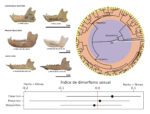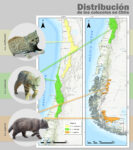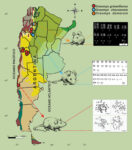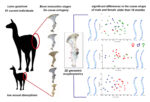Distribución espacial y horarios de actividad de la fauna nativa y exótica de mediano y gran tamaño en el Parque Nacional El Palmar, Entre Ríos, Argentina
Ilán Shalom
Revista Científica SAREM–SBMz





Os primatas têm uma história de vida complexa, ampla distribuição geográfica e variabilidade ecológica e reprodutiva, características que podem contribuir para a variação fenotípica. Eles podem ser divididos em três grandes grupos monofiléticos: Strepsirrhini de Madagascar, África continental e Ásia; Catarrhini da África, Europa e Ásia; e Platyrrhini da América do Norte, Central e do Sul. O presente estudo pretende descrever a variação do dimorfismo de tamanho da mandíbula nos clados de primatas, com dados padronizados utilizando a morfometria geométrica. Calculamos o índice de dimorfismo sexual para 102 espécies de primatas (19 Strepsirrhini, 54 Catarrhini e 29 Platyrrhini). Constatamos que machos tendem a ser frequentemente maiores que as fêmeas, embora o contrário também aconteça com alguma frequência. A disparidade, quantidade de variação, do índice do dimorfismo é maior em Platyrrhini, seguido de Catarrhini e por último Strepsirrhini. A maior disparidade em Platyrrhini se deve principalmente à alta variação do dimorfismo em Callitrichidae, que apresenta altos valores de dimorfismo tanto com viés para fêmeas quanto para machos, e aos altos valores de dimorfismo com viés para machos em Atelidae e Cebidae. Catarrhini apresenta dimorfismo mais frequentemente relacionado ao aumento do tamanho de machos, enquanto em Strepsirrhini os animais tendem a ser monomórficos. Nossos resultados indicam a possibilidade de que a evolução do dimorfismo do tamanho seja resultado de processos adaptativos e biogeográficos ao longo da diversificação do grupo. Encorajamos estudos futuros a analisarem diferentes hipóteses adaptativas na evolução do dimorfismo de tamanho em Primatas.
Sexual size dimorphism in clades of primates. Primates have complex life histories, wide geographic distributions, and ecological and reproductive variability, characteristics that may contribute to phenotypic variation. They can be divided into three major monophyletic groups: Strepsirrhini from Madagascar, continental Africa, and Asia; Catarrhini in Africa and Asia; and Platyrrhini in the Americas. Here, we aimed to describe the size dimorphism of the mandible in the main primate clades using standardized geometric morphometric data. We calculated the index of sexual dimorphism for 102 primate species (19 Strepsirrhini, 54 Catarrhini, and 29 Platyrrhini). Our results show that males are often larger than females, although the opposite also occurs with some frequency. The disparity of sexual dimorphism, the amount of variation, is higher in Platyrrhini, followed by Catarrhini, and then Strepsirrhini primates. The higher disparity in Platyrrhini is particularly due to the high disparity in Callitrichidae, which have high values for both female- and male-bias dimorphism, along with the high levels of male-biased sexual dimorphism in Atelidae and Cebidae. Catarrhini sexual dimorphism is frequently male-biased, while Strepsirrhini species tend to be more monomorphic. Our results suggest that the evolution of sexual dimorphism may be a consequence of adaptive and biogeographic processes throughout the diversification of the groups. We encourage future studies to analyze different adaptive hypotheses for the evolution of sexual size dimorphism in primates.

Extreme stochastic perturbations can affect population dynamics, but quantitative assessments are scarce for threatened species. The 2015–2016 El Niño-Southern Oscillation (ENSO) caused extreme flooding in the Delta of the Paraná River in Argentina where the southernmost population of the regionally endangered marsh deer (Blastocerus dichotomus) occurs. Using field surveys and data from informants, we studied the impact of this flood on the mortality, distribution, and abundance of this marsh deer population in an area of 1236 km². The occurrence of this extreme flood significantly increased marsh deer mortality. One hundred forty-two marsh deer deaths were recorded over the seven-month flood duration, with poaching accounting for 86.6% of deaths. Mortality of marsh deer was significantly higher near urban areas, embankments, and dirt roads, while mortality from poaching was higher in plantations and permanently inundated lands. Two areas of high spatial clustering of poaching mortality were detected, encompassing plantations with easy access or in proximity to urban areas, while embankments appeared to act as attractive population sinks. Flood-related mortality significantly decreased the occurrence of the species in the study area after the flood, but changes in relative abundance between periods were heterogeneous across the landscape, probably because of local migrations. Since climate change is expected to increase the global frequency and magnitude of extreme flood events, our study provides valuable information for mitigating the negative synergistic effects of extreme flooding on marsh deer, as well as for global wildlife populations subjected to periodic extreme floods.
Las inundaciones extremas incrementan la mortalidad por cacería en el refugio más austral del amenazado ciervo de los pantanos. Las perturbaciones estocásticas extremas pueden afectar la dinámica de las poblaciones, pero las evaluaciones cuantitativas son escasas para las especies amenazadas. El fenómeno de «El Niño» de 2015–2016 causó inundaciones extremas en el Delta del río Paraná en Argentina, donde se encuentra la población más austral del ciervo de los pantanos (Blastocerus dichotomus), categorizada como En Peligro a nivel regional. En base a relevamientos de campo y datos de informantes, estudiamos el impacto de esta inundación sobre la mortalidad, distribución y abundancia de esta población de ciervo de los pantanos dentro de un área de 1236 km². La ocurrencia de esta inundación incrementó significativamente la mortalidad del ciervo de los pantanos. Hemos registrado 142 individuos muertos durante los siete meses de duración de la inundación, y la caza furtiva representó el 86.6% de las muertes. La mortalidad del ciervo de los pantanos fue significativamente mayor en proximidad a áreas urbanas, terraplenes y caminos vehiculares, mientras que la mortalidad por cacería fue mayor en plantaciones y terrenos permanentemente inundados. Se detectaron dos áreas de alta concentración espacial de mortalidad por cacería, que abarcaron plantaciones de fácil acceso o próximas a áreas urbanas, mientras que los terraplenes parecen haber funcionado como sumideros atractivos para los ciervos. La mortalidad relacionada con las inundaciones disminuyó significativamente la presencia de la especie dentro del área de estudio luego de la inundación, pero los cambios en la abundancia relativa entre períodos fueron heterogéneos en todo el paisaje, probablemente como resultado de migraciones locales. Dado que se espera que el cambio climático aumente la frecuencia global y la magnitud de las inundaciones extremas, nuestro estudio proporciona información valiosa para mitigar los efectos sinérgicos negativos de las inundaciones extremas tanto en el ciervo de los pantanos como en poblaciones de otras especies sujetas a inundaciones extremas periódicas.

The three colocolo cat populations (Leopardus colocola) in Chile are associated with the Altiplano, the Mediterranean forest and the Patagonian steppes. They have traditionally been considered isolated and distant from each other, and have even been potentially viewed as different species by some authors. We used available information and the georeferenced data obtained from our own observations (through direct observations, images from trail cameras, indirect signs of the species, museum records, description of the areas in scientific literature and georeferencing applications). We created an updated distribution map for the entire country and compared it to historical distribution maps. We have contributed to over 207 unpublished records, defining for the first time the distribution of L. c. wolffsohni from the Region of Arica and Parinacota to the town of “El Chollay”. We also contributed to increase the distribution of L. c. colocola by more than 300 km to the north (near Paposo) and define its southern limit in the sector of Laguna del Laja. As for the subspecies L. c. pajeros, this would be associated with the Patagonian steppe ecosystem. The subspecies L. c. wolffsohni and L. c. colocola have a wider distribution than reported in the scientific literature and are probably even connected, since there are no natural boundaries separating them and their records are 46 km apart. The updated maps will support future taxonomic analyses and help detect the principal threats that endanger the species (such as mining activity and land-use change).
Evaluación de la distribución actual del gato colocolo Leopardus colocola (Molina 1782) en Chile y sus implicaciones en la taxonomía de la especie. Las tres poblaciones de gato colocolo (Leopardus colocola) en Chile están asociadas al altiplano, el bosque mediterráneo y las estepas patagónicas. Estas han sido tradicionalmente consideradas como aisladas y distantes una de otras, y han sido potencialmente vistas como diferentes especies por algunos autores. Usamos la información disponible y los datos georreferenciados de nuestras observaciones (a través de observaciones directas, imágenes de cámaras trampa, registros indirectos de la especie, registros de museos, áreas descritas en la literatura científica y aplicaciones de georreferencia), y hemos creado un mapa actualizado de la distribución para todo el país, que comparamos con los mapas de distribución histórica. Contribuimos con más de 207 registros no publicados para la primera distribución de L. c. wolffsohni, que iría desde las regiones de Arica y Parinacota a la localidad de «El Chollay». Incrementamos la distribución de L. c. colocola en más de 300 km al norte (cerca de Paposo) y definimos su límite sur en el sector de laguna del Laja. En cuanto a la distribución de L. c. pajeros, esta podría estar asociada con el ecosistema de la estepa patagónica. Las subespecies L. c. wolffsohni y L. c. colocola tienen una distribución más amplia que la informada por la literatura científica y probablemente estén conectadas debido a que no existen barreras naturales que las separen, y sus registros están separados por 46 km. La actualización de los mapas de distribución contribuirá para futuros análisis taxonómicos y ayudarán a evaluar las principales amenazas que enfrenta la especie (como actividad minera o cambio de uso de suelo).

The genus Graomys contains four species and presents significant karyological diversity. Graomys griseoflavus, inhabiting mainly the Monte Desert ecoregion, shows variations in diploid number (2n) from 33 to 38 due to Robertsonian translocations and in fundamental number of autosomal arms (FNa) from 44 to 48 due to inversions. Graomys chacoensis, which occurs in the ecoregions of the Chaco and the Espinal, has 2n = 42 and FNa = 44–46 due to a pericentric inversion. Graomys domorum, which inhabits the Yungas ecoregion and the Yungas-Chaco transitional zones exhibits 2n = 28 and FNa = 46, but its karyotype is known only by a schematic representation for two specimens from Bolivia. The karyotype of G. edithae has not yet been described. In this report, we studied 29 individuals of the three former species from different localities of their distribution, using conventional and differential cytogenetic techniques and chromosome measurements. In G. griseoflavus, we have identified the pairs involved in the three Robertsonian translocations, supporting an independent, not sequential origin of this polymorphism. The nearby area of Mendoza City showed the greatest chromosomal diversity for G. griseoflavus. The banding pattern associated with the chromosomal measurements allowed us to suggest the possible pairs involved in the pericentric inversions of G. griseoflavus and G. chacoensis. The presence of heterochromatin indicates more significant chromosomal variability and complexity than previously recognized. The chromosome complements of G. chacoensis and G. griseoflavus are more similar to each other. The karyotype of G. domorum from Argentina differs from the previously reported from Bolivia, and is the most divergent within the genus.
Diversidad cariotípica en el género Graomys Thomas, 1916 (Rodentia, Cricetidae, Sigmodontinae). El género Graomys contiene cuatro especies y presenta una diversidad cariológica significativa. Graomys griseoflavus habita en la ecorregión del Desierto del Monte y muestra variaciones en el número diploide (2n) de 33 a 38 debido a translocaciones robertsonianas, y en el número fundamental de brazos autosómicos (FNa) de 44 a 48 debido a inversiones. Graomys chacoensis se encuentra en las ecorregiones del Chaco y el Espinal, y tiene 2n = 42 y FNa = 44–46 debido a una inversión pericéntrica. Graomys domorum habita en la ecorregión de Yungas y en zonas de transición con el Chaco, y exhibe 2n = 28 NFa = 46, pero su cariotipo sólo se conoce por una representación esquemática para dos especímenes de Bolivia. El cariotipo de G. edithae no ha sido descrito. En este trabajo estudiamos 29 individuos de las tres primeras especies distribuidos en diferentes localidades, utilizando técnicas citogenéticas convencionales, diferenciales y mediciones cromosómicas. En G. griseoflavus identificamos los pares involucrados en las tres translocaciones Robertsonianas, apoyando un origen independiente, no secuencial de este polimorfismo. El área cercana a Mendoza alberga la mayor diversidad cromosómica de G. griseoflavus. El patrón de bandas y las medidas cromosómicas nos han permitido sugerir los posibles pares involucrados en las inversiones pericéntricas de G. griseoflavus y G. chacoensis. La presencia de heterocromatina indica variabilidad cromosómica adicional y una mayor complejidad de lo que se reconocía previamente. Los complementos cromosómicos de G. griseoflavus y G. chacoensis son muy similares. El cariotipo de G. domorum de Argentina difiere del informado en Bolivia y es el más divergente dentro del género.

El guanaco presenta un bajo dimorfismo sexual a nivel esqueletal. Los principales estudios que evalúan las diferencias osteológicas entre machos y hembras en esta especie se basan en el análisis de variables morfométricas dentales y en caracteres morfológicos cualitativos y osteométricos de la pelvis. En guanacos adultos se han identificado variables de tamaño sensibles a la discriminación sexual en el ilion, acetábulo y caninos. El objetivo de este trabajo es explorar la variación sexual en la forma de los coxales a lo largo del desarrollo ontogenético del guanaco. Para ello, se analizaron 61 individuos actuales procedentes de la localidad de Cinco Chañares (provincia de Río Negro, Argentina): 38 guanacos inmaduros (0–36 meses) y 23 guanacos adultos (48–144 meses). Sobre estos individuos se evaluó el estadio de maduración ósea de los coxales y se aplicaron técnicas de morfometría geométrica basadas en landmarks y semilandmarks digitalizados a partir de imágenes 2D. Los análisis multivariados mostraron que existen diferencias significativas en la forma de los coxales entre individuos machos y hembras, fundamentalmente en guanacos mayores de 19 meses de vida. Este trabajo resulta un importante avance hacia el desarrollo de un sistema confiable de estimación sexual para individuos juveniles, subadultos y adultos a través del análisis de una porción ósea que tiene buenas posibilidades de sobrevivir en el registro fósil.
Ontogeny and sexual dimorphism in the pelvis of the guanaco. A morphogeometric evaluation. The guanaco presents a low sexual dimorphism at the skeletal level. The main studies that evaluate the osteological differences between males and females in this species are based on the analysis of morphometric dental variables and qualitative and osteometric morphological characters of the pelvis. From them, variables of size sensitive to sexual discrimination in the ilium, acetabulum, and canines of adult guanacos have been identified. The objective of this work is to explore the sexual variation in the shape of the coxae throughout the ontogenetic development of the guanaco. To this end, 61 current individuals from the locality of Cinco Chañares (Province of Río Negro, Argentina) were analyzed, 38 immature individuals (0–36 months) and 23 adult individuals (48–144 months). The bone maturation stages of the innominate bones were evaluated, and geometric morphometric techniques based on landmarks and semi-landmarks digitized from 2D images were applied. Multivariate analyzes showed that there are significant differences in the shape of the coxae of male and female individuals, especially in guanacos older than 19 months. This work is an important advance toward the development of a reliable system of sexual estimation for juvenile, subadult, and adult individuals through the analysis of a bone portion that has a good chance of surviving in the fossil record.
